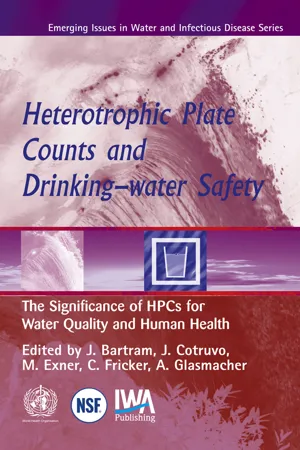
eBook - PDF
Heterotrophic Plate Counts and Drinking-water Safety
- 150 pages
- English
- PDF
- Available on iOS & Android
eBook - PDF
Heterotrophic Plate Counts and Drinking-water Safety
About this book
Heterotrophic Plate Counts and Drinking-water Safety provides a critical assessment of the role of the Heterotrophic Plate Count (HPC) measurement in drinking water quality management. It was developed from an Expert workshop of 32 scientists convened by the World Health Organization and the WHO/NSF International Collaborating Centre for Drinking Water Safety and Treatment in Geneva, Switzerland. Heterotrophs are organisms, including bacteria, yeasts and moulds, that require an external source of organic carbon for growth. The HPC test (or Standard Plate Count), applied in many variants, is the internationally accepted test for measuring the hetrotrophic microorganism population in drinking water, and also other media. It measures only a fraction of the microorganisms actually present and does not distinguish between pathogens and non-pathogens. High levels of microbial growth can affect the taste and odor of drinking water and may indicate the presence of nutrients and biofilms which could harbor pathogens, as well as the possibility that some event has interfered with the normal production of the drinking water. HPC counts also routinely increase in water that has been treated by an in-line device such as a carbon filter or softener, in water-dispensing devices and in bottled waters and indeed in all water that has suitable nutrients, does not have a residual disinfectant, and is kept under sufficient conditions. There is debate among health professionals as to the need, utility or quantitative basis for health-based standards or guidelines relating to HPC-measured regrowth in drinking water. The issues that were addressed in this work include: the relationship between HPC in drinking water (including that derived from in-line treatment systems, dispensers and bottled water) and health risks for the general public the role of HPC as an indirect indicator or index for pathogens of concern in drinking water the role of HPC in assessing the efficacy and proper functioning of water treatment and supply processes the relationship between HPC and the aesthetic acceptability of drinking water. Heterotrophic Plate Counts and Drinking-water Safety provides valuable information on the utility and the limitations of HPC data in the management and operation of piped water systems as well as other means of providing drinking water to the public. It is of particular value to piped public water suppliers and bottled water suppliers, manufacturers and users of water treatment and transmission equipment and inline treatment devices, water engineers, sanitary and clinical microbiologists, and national and local public health officials and regulators of drinking water quality.
Frequently asked questions
Yes, you can cancel anytime from the Subscription tab in your account settings on the Perlego website. Your subscription will stay active until the end of your current billing period. Learn how to cancel your subscription.
At the moment all of our mobile-responsive ePub books are available to download via the app. Most of our PDFs are also available to download and we're working on making the final remaining ones downloadable now. Learn more here.
Perlego offers two plans: Essential and Complete
- Essential is ideal for learners and professionals who enjoy exploring a wide range of subjects. Access the Essential Library with 800,000+ trusted titles and best-sellers across business, personal growth, and the humanities. Includes unlimited reading time and Standard Read Aloud voice.
- Complete: Perfect for advanced learners and researchers needing full, unrestricted access. Unlock 1.4M+ books across hundreds of subjects, including academic and specialized titles. The Complete Plan also includes advanced features like Premium Read Aloud and Research Assistant.
We are an online textbook subscription service, where you can get access to an entire online library for less than the price of a single book per month. With over 1 million books across 1000+ topics, we’ve got you covered! Learn more here.
Look out for the read-aloud symbol on your next book to see if you can listen to it. The read-aloud tool reads text aloud for you, highlighting the text as it is being read. You can pause it, speed it up and slow it down. Learn more here.
Yes! You can use the Perlego app on both iOS or Android devices to read anytime, anywhere — even offline. Perfect for commutes or when you’re on the go.
Please note we cannot support devices running on iOS 13 and Android 7 or earlier. Learn more about using the app.
Please note we cannot support devices running on iOS 13 and Android 7 or earlier. Learn more about using the app.
Yes, you can access Heterotrophic Plate Counts and Drinking-water Safety by Jamie Bartram,J. A. Cotruvo,M. Exner,C. Fricker,A. Glasmacher in PDF and/or ePUB format, as well as other popular books in Technology & Engineering & Environmental Science. We have over one million books available in our catalogue for you to explore.
Information
Table of contents
- Cover
- Contents
- Foreword
- Acknowledgements
- List of acronyms and abbreviations
- Robert Koch
- 1: Expert consensus
- 2: Public health aspects of the role of HPC — an introduction
- 3: The history and use of HPC in drinking-water quality management
- 4: The presence of bacteria in water after regrowth
- 5: Bacteria of potential health concern
- 6: Relationships between common water bacteria and pathogens in drinking-water
- 7: Epidemiological and riskassessment evidence of diseaselinked to HPC bacteria
- 8: Infections from HPC organisms in drinking-water amongst the immunocompromised
- 9: Methods to identify and enumerate frank and opportunistic bacterial pathogens in water and biofilms
- 10: Conditions favouring coliform and HPC bacterial growth in drinkingwater and on water contact surfaces
- 11: Managing regrowth in drinkingwater distribution systems
- 12: The role of HPC in managing the treatment and distribution of drinking-water
- Index